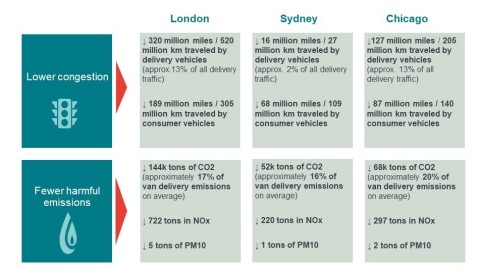Enhanced Last-Mile Delivery Can Reduce Traffic Congestion and Air Emissions in Cities, Accenture Report Finds
Accenture's latest study highlights how local micro-fulfilment centers (MFCs) can transform last-mile delivery in Chicago, London, and Sydney, potentially cutting delivery vehicle emissions by 16%-26% by 2025. Using MFCs to fulfill half of e-commerce orders could decrease traffic by 13% in London and Chicago, and 2% in Sydney. This shift could lead to significant CO₂ reductions, particularly 144,000 tons in London. The study recommends collaborative strategies involving governments and retailers to enhance sustainability and efficiency in delivery practices.
- Potential emission reductions of 16%-26% in delivery vehicles by 2025 through MFCs.
- Significant CO₂ emissions reduction projected: 144,000 tons in London, 68,000 tons in Chicago, and 52,000 tons in Sydney.
- Traffic reduction benefits: 13% in both London and Chicago, and 2% in Sydney.
- None.
Insights
Analyzing...
By taking bold steps to transform how last-mile delivery ecosystems operate, post and parcel organizations, retailers and delivery companies could reduce harmful emissions and traffic congestion within cities, according to a new study by Accenture (NYSE: ACN) undertaken in collaboration with Frontier Economics.

The Accenture study identifies achievable reductions in the levels of harmful air emissions arising from a reduction in delivery vehicle volumes in the cities of Chicago, London and Sydney. (Photo: Business Wire)
The report, “The Sustainable Last Mile: Faster. Greener. Cheaper.,” found that using local micro-fulfilment centers (MFCs) across Chicago, London and Sydney to fulfill just half of the e-commerce orders in those cities could significantly reduce traffic volume and harmful air emissions — and that last-mile supply chains using MFCs could lower delivery vehicle-related emissions
A flexible logistics solution for e-commerce, MFCs enable inventory to be stored closer to customers in convenient suburban locations, enhancing supply chain processes, speeding up last-mile deliveries and enabling in-person pick-up of parcels. MFCs include in-store click and collect points, automated locker storage facilities, and stand-alone micro-warehouse facilities.
Increasing the use of MFCs to enable same-day or next-day deliveries provides retailers and postal and logistics organizations with operational benefits while simultaneously creating significant positive environmental and societal impact, according to the study.
Of the three cities included in the study, London would likely see the largest delivery traffic reduction from the use of MFCs —
“The carbon footprint of the last mile has long been an environmental and societal challenge,” said André Pharand, a managing director at Accenture who leads the company’s postal & parcel practice. “It’s time to take action and make the last mile supply chain more efficient, less expensive, and more sustainable. Organizations with innovative local fulfilment strategies and that lead in digital adoption and sustainable business practices will become tomorrow’s industry leaders.”
The study identifies substantial and achievable reductions in the emissions of carbon dioxide (CO₂), nitrogen oxides (NOx) and particulate matter (PM10) arising from a reduction in delivery vehicle volumes through the increased use of MFCs. The greatest CO₂ reductions could be achieved in London (144,000 tons), followed by Chicago (68,000 tons) and Sydney (52,000 tons). The offering of convenient ‘click-and-collect’ options by retailers could encourage consumers to travel in-person — whether by low-emission vehicles such as private cars, by zero-emission vehicles such as bicycles, or on foot — to collect parcels at local fulfilment centers, further contributing to reduced consumer traffic volumes and vehicle emissions.
To help capitalize on the opportunity, the report identifies key strategies for transforming last-mile delivery practices. These include governments and retailers incentivizing greener choices among consumers and businesses; delivery companies and postal agencies re-assessing how they manage their supply chains and deploy assets such as heavy goods vehicles; and the greater use of data and analytics technologies by e-commerce retailers and logistics organizations.
The study also found that deploying route optimization technologies alongside MFCs could reduce delivery traffic by an additional
“No single entity can solve the challenge of last-mile delivery alone,” Pharand said. “It will take an ecosystem of partners working together to create a major evolution in sustainable delivery practices through the pairing of human ingenuity with technology. We believe that our study points the way forward.”
Research Methodology
In late 2020 Accenture and Frontier Economics developed an economic model of the impact of local fulfilment centers for e-commerce using data from London, Chicago, and Sydney. The model estimates the impact on outputs such as emissions and traffic congestion, based on inputs including local fulfilment center prevalence, population density, average distance travelled per parcel, delivery vehicle mix and consumer demand projections. Accenture modeled the impact of fulfilling
About Accenture
Accenture is a global professional services company with leading capabilities in digital, cloud and security. Combining unmatched experience and specialized skills across more than 40 industries, we offer Strategy and Consulting, Interactive, Technology and Operations services — all powered by the world’s largest network of Advanced Technology and Intelligent Operations centers. Our 537,000 people deliver on the promise of technology and human ingenuity every day, serving clients in more than 120 countries. We embrace the power of change to create value and shared success for our clients, people, shareholders, partners and communities. Visit us at www.accenture.com.
View source version on businesswire.com: https://www.businesswire.com/news/home/20210323005045/en/






